AMD Ryzen 7 8700G and Ryzen 5 8600G Review: Zen 4 APUs with RDNA3 Graphics
by Gavin Bonshor on January 29, 2024 9:00 AM EST- Posted in
- CPUs
- AMD
- APUs
- Phoenix
- 4nm
- Zen 4
- RDNA3
- AM5
- Ryzen 8000G
- Ryzen 7 8700G
- Ryzen 5 8600G
CPU Benchmark Performance: Rendering
Rendering tests, compared to others, are often a little more simple to digest and automate. All the tests put out some sort of score or time, usually in an obtainable way that makes it fairly easy to extract. These tests are some of the most strenuous in our list, due to the highly threaded nature of rendering and ray-tracing, and can draw a lot of power.
If a system is not properly configured to deal with the thermal requirements of the processor, the rendering benchmarks are where it would show most easily as the frequency drops over a sustained period of time. Most benchmarks, in this case, are re-run several times, and the key to this is having an appropriate idle/wait time between benchmarks to allow for temperatures to normalize from the last test.
Some of the notable rendering-focused benchmarks we've included for 2024 include the latest CineBench 2024 benchmark and an update to Blender 3.6 and V-Ray 5.0.2.
We are using DDR5-5200 memory as per the JEDEC specifications on the Ryzen 7 8700G and Ryzen 5 8600G, as well as DDR4-3200 on the Ryzen 7 5700G and Ryzen 5 5600G. The same methodology is also used for the AMD Ryzen 7000 series and Intel's 14th, 13th, and 12th Gen processors. Below are the settings we have used for each platform:
- DDR5-5200 CL44 - Ryzen 8000G
- DDR4-3200 CL22 - Ryzen 5000G
- DDR5-5600B CL46 - Intel 14th & 13th Gen
- DDR5-5200 CL44 - Ryzen 7000
- DDR5-4800 (B) CL40 - Intel 12th Gen
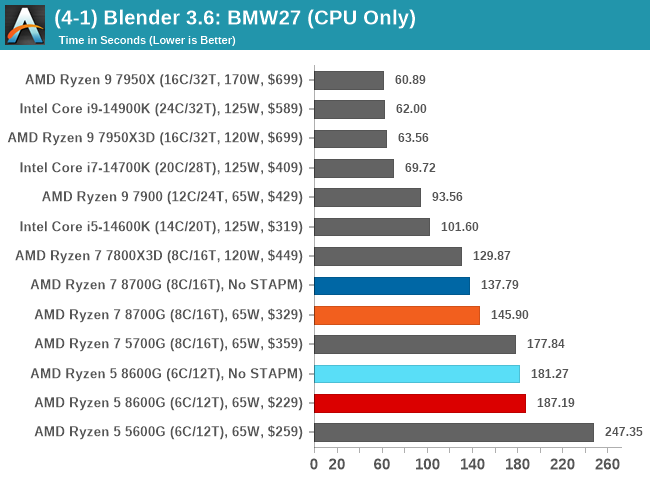
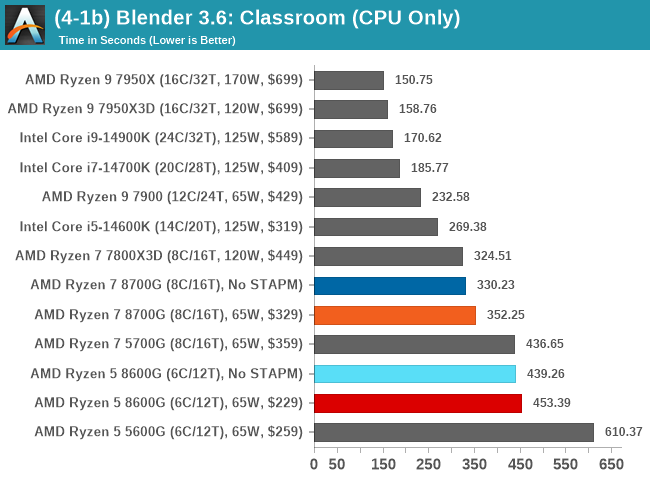
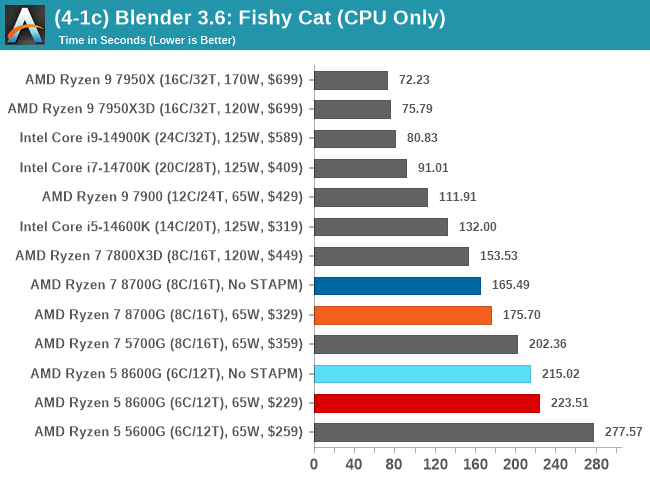
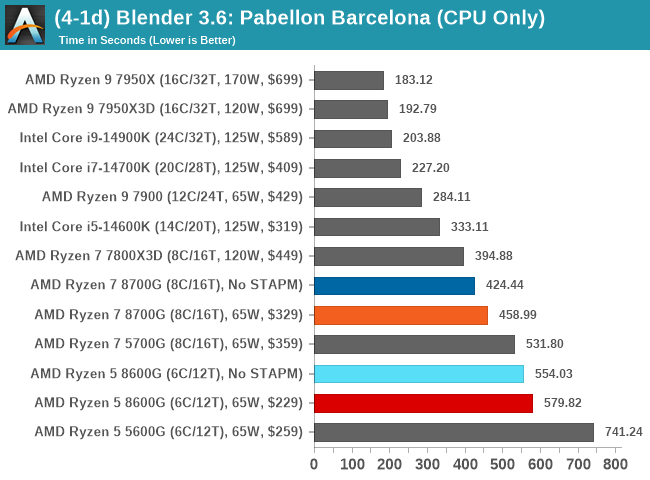

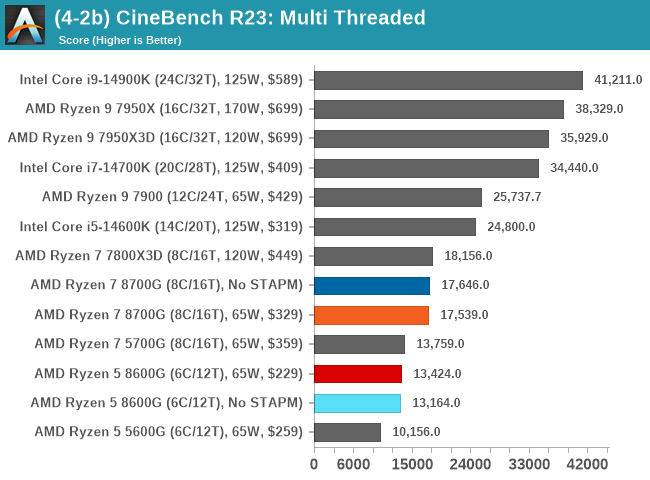
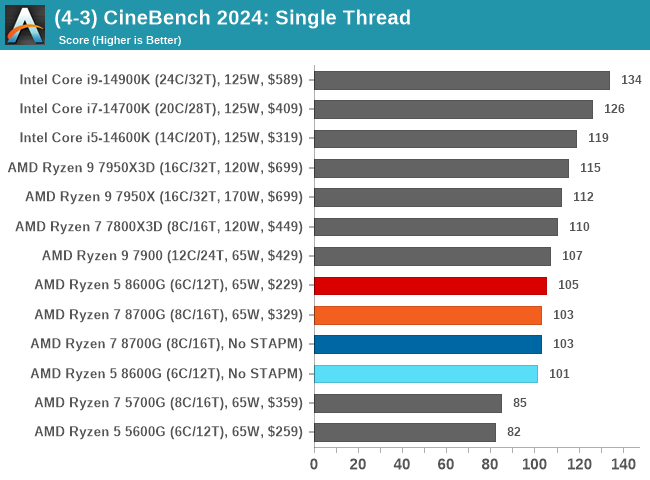
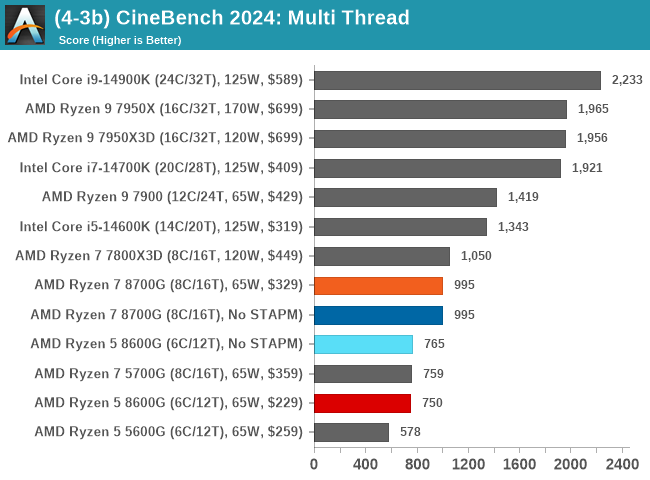

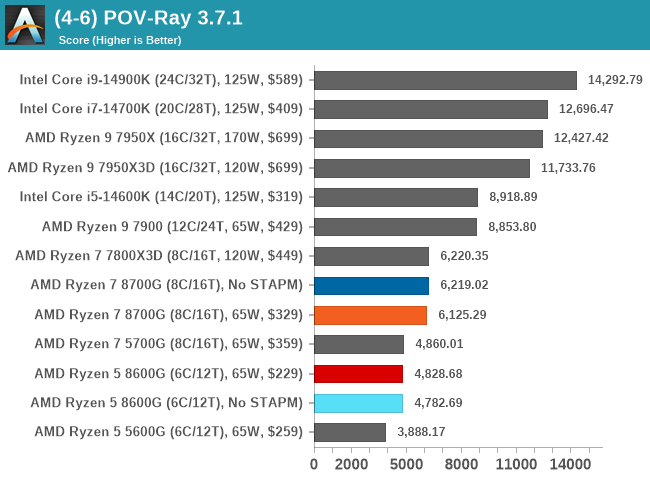
Another area where a mobile-based chip ported to a desktop doesn't quite match the bigger desktop chips is in rendering, a quintessential power and multi-threaded scenario where more cores and threads typically equate to higher performance. Both the Ryzen 7 8700G and Ryzen 5 8600G beat out the Ryzen 5000G series APUs, although the Ryzen 7 5700G consistently beats the Ryzen 5 8600G as we would expect from having two more cores with four more threads.
In our rendering tests without STAPM limitations, we saw notable gains in performance in Blender 3.6. The performance increase without sustained power loads being limited, we're seeing up to 7.5% better performance across the longer tests, with around 5% more performance in the shorter tests.










111 Comments
View All Comments
James5mith - Monday, January 29, 2024 - link
"These limitations primarily come in highly intensive multi-threaded workloads such as rendering or encoding, where the performance of processors such as the Ryzen 7000 desktop series, but the key point is that these APUs aren't inherently designed for these tasks in mind, and users looking for more CPU grunt are almost certainly likely to opt for a higher grade processor with faster cores, more cores, and more threads. "That is a) a massive run-on sentence, and b) doesn't make much actual sense. For example:
"where the performance of processors such as the Ryzen 7000 desktop series"
Where the performance does what? Or is what? There is no coherent thought in that comma delimited side note.
GeoffreyA - Tuesday, January 30, 2024 - link
The performance of the 7000 series excels at multithreading.yankeeDDL - Monday, January 29, 2024 - link
I wish there were some more remarks vs Intel's offering.CPU-wise Ryzen is more efficient, generally speaking. The performance seems same or slightly lower when compared with CPU that burn 400W to reach crazy boost rate. Still, that's my view.
Comparing it only against Ryzen 5*** seems a bit limited, no?
meacupla - Monday, January 29, 2024 - link
Ryzen 5000G is the primary competitor for Ryzen 8000G.It's next closest competition comes from the mobile segment in the form of mini-PCs.
Intel hasn't offered an APU for its desktop socket in ages.
yankeeDDL - Thursday, February 1, 2024 - link
Not correct.Ryzen 8000G is the only Zen4 desktop CPU on TSMC 4nm process (Ryzen 7000 is also Zen4, but on 5nm).
So - iGPU aside - I expect the 8000G to be more efficient than the 7000. Hence, I am curious as to how it would perform against Intel and also against the 7000.
Grapple - Monday, January 29, 2024 - link
Comparing against Intel’s 65W T-series processors would have made this article much more interesting.FWhitTrampoline - Monday, January 29, 2024 - link
T series is 35W and mostly for thin client Mini Desktop Business PCs but at least the T series are Socket Packaged! And Intel Made a Big mistake not releasing at least a 65W Socket Packaged Meteor Lake SKU. And Intel is very well capable of offering a socket packaged Mobile Processor because I'm still using my HP ProBook 4540s laptop with a Socket Packaged Ivy Bridge generation 3632QM processor and that laptop can get a processor update of MB replacement and reuse the same processor!meacupla - Monday, January 29, 2024 - link
I disagree. But only on processor choice.Ryzen 7840HS, Intel i7-13700H and i7-1370P would be my choice.
TheinsanegamerN - Tuesday, January 30, 2024 - link
Given that this is a desktop chip, it'd make more sense to compare it to other desktop chips.Otherwise, throw an M3 and a nvidia t100 car processor while youre at it.
meacupla - Tuesday, January 30, 2024 - link
Hahaha, nope.8000G are mobile chips using a desktop socket.